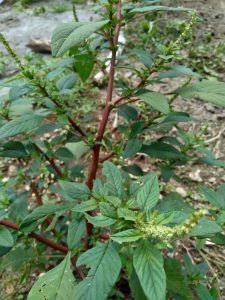BOTANICAL NAME: Amaranthus tricolor
FAMILY: Amaranthaceae
CLASSICAL CLASSIFICATION:
BHAVAPRAKASHA: Shaka varga
ENGLISH NAME: Edlebur, Prickly Amaranth
COMMON NAME:
Kannad: Mulluharive soppu
Hindi: Chaulai
Bengali: kantanatya

REFERENCE: BHAVAPRAKASH SAMHITA with link e Nighantu:
https://niimh.nic.in/ebooks/e-Nighantu/bhavaprakashanighantu/?mod=read
तण्डुलीयो मेघनादः काण्डेरस्तण्डुलेरकः |
भण्डीरस्तण्डुलीबीजो विषघ्नश्चाल्पमारिषः ||१०||
तण्डुलीयो लघुः शीतो रूक्षः पित्तकफास्रजित् |
सृष्टमूत्रमलो रुच्यो दीपनो विषहारकः |
जलतण्डुलीय-
पानीयं तण्डुलीयं तु कचटं समुदाहृतम् |
कचटं तिक्तकं रक्तपित्तानिलहरं लघु
HABITAT: India, America
BOTANICAL DESCRIPTION:
Amaranthus is an annual erect herb, growing up to 100 – 130 cm long. Stem is usually branched, cylindrical, smooth, glabrous or slightly pubescent, green or red tinged. Leaves are alternate, simple, ovate to rhombic-ovate, elliptic, lanceolate-oblong, or lanceolate. Flowers are green in color. Fruit oblong dehiscent capsule with one seed. Seeds are about 1 mm diameter, shiny black color.
AYURVEDIC CHARACTERISTICS:
| RASA | GUNA | VEERYA | VIPAKA | PRABHAVA | DOSHGHNTA |
| Madhura | Laghu, ruksha | Shita | Madhura | Deepana | Pittakaphahara |
AYURVEDIC ENERGETICS:
| TASTE | PROPERTY | POTENCY | POST DIGESTIVE EFFECT | EFFECT ACTION | DOSHA ACTION |
| Sweet | Light, dry | Cooling | Sweet | Digestion | Pitta and kapha pacifying |
MAJOR CHEMICAL CONSTITUENTS: Alkaloids, flavonoids, glycosides, phenolic acids, steroids, amino acids, terpenoids.
THERAPEUTIC USES:
- Menorrhagia: Root of tanduliyaka is given with honey.
- Skin disease: Root paste is applied over affected parts.
- Jaundice: Leaves are boiled and given for 2-3 days.
USEFUL PART: Leaves, roots
AYURVEDIC FORMULATION:
1. Chandanadi lepam
2. Griha dhuma
